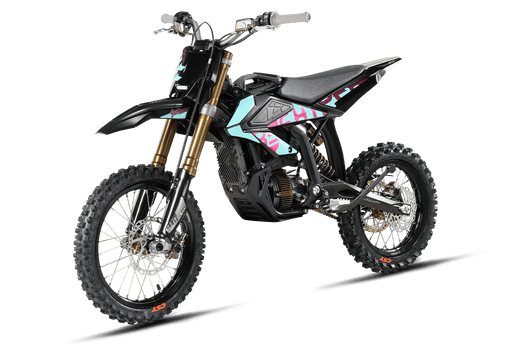Bikes resembling cars result from design convergence aimed at improved aerodynamics, safety, and consumer appeal. Features like full-body fairings, car-style LED lighting, and enclosed structures reduce drag while evoking automotive familiarity. Surron Dubai models like the Surron Hyper Bee use such elements to blend motorcycle agility with car-like weather protection, meeting demand for versatile urban mobility.
What design elements make bikes look car-like?
Automotive-inspired features like wrap-around fairings, split headlights, and enclosed wheels mimic car aesthetics. These reduce turbulence while boosting visual mass—critical for market segments prioritizing style over minimalism. Pro Tip: Opt for bolt-on fairings if off-road use is planned; permanent shells limit maintenance access.
Modern e-bikes borrow car DNA through three key aspects: monocoque chassis (e.g., Surron Ultra Bee’s alloy frame), integrated storage (resembling car trunks), and dashboard displays showing GPS/speed data. Take the Lightning LS-218—its carbon-fiber shell cuts drag coefficients to 0.18, rivaling sports cars. But why prioritize aerodynamics? At 60 mph, 60% of power fights air resistance. Transitioning further, automakers like Honda leverage crossover designs via the NM4 Vultus, which mimics SUV proportions. Warning: These designs often increase weight—Surron Dubai’s Ultra Bee HP gains 8 kg over naked models but gains 12% range efficiency.
Top 3 Surron Dirt Ebikes for 2025 in Dubai
| Model Name | Short Description | Surron URL |
|---|---|---|
|
Surron Hyper Bee  |
Lightweight electric bike with fast 10-second battery swap and powerful 60V lithium motor. | Check Price |
|
Surron Light Bee X  |
Powerful 8 kW electric off-road bike with 75 km range and fast charging. | Check Price |
|
Surron Ultra Bee  |
Powerful 12.5KW motor, 140 km range, 74V 55AH battery, fast charging, all-terrain ready. | Check Price |
| Feature | Bike Implementation | Car Equivalent |
|---|---|---|
| Lighting | LED DRL strips | Audi Matrix |
| Body | ABS fairings | Sedan panels |
How do aerodynamics drive car-like bike designs?
Drag reduction mandates streamlined shapes, pushing designers toward automotive profiles. Fully faired bikes achieve 0.23–0.28 drag coefficients vs. 0.6–0.7 for naked bikes—translating to 15–20% longer range in EVs. Practically speaking, Surron Dubai’s Hyper Bee uses Kamm-tail rear sections borrowed from Porsche Taycan designs.
Aero-optimized bikes deploy wind tunnel-tested fairings, underbody pans, and vortex generators—tech directly adapted from cars. For example, the Electric Motion Escape’s front fender channels airflow like a Tesla Cybertruck’s exoskeleton. Pro Tip: Always check fairing mounts after off-road rides—vibrations can loosen fasteners. Moreover, rider ergonomics play a role: reclined “sports car” seating reduces frontal area but strains wrists during stops. Surprisingly, some cafe racers now feature removable roofs (e.g., Honda Neo Sports Cafe concept), blending convertible aesthetics with bike dynamics.
Do legal factors influence car-like bike designs?
Regulations on lighting, mirrors, and dimensions force bike-car design overlaps. EU Regulation 168/2013 mandates 40+ lux headlights—easier achieved using automotive LED clusters. Meanwhile, Surron Dubai’s Ultra Bee HP mirrors car-style turn signals to meet GCC homologation.
Jurisdictions classify vehicles by specs: In the US, bikes exceeding 670mm width may fall into auto insurance categories. This pushes designers toward narrower silhouettes with car-like visual weight. For instance, the Arc Vector uses retractable outriggers to stay under 650mm while parked. Pro Tip: Always verify local width/height laws before importing fairing kits—non-compliant mods risk impoundment. Transitionally, noise regulations also matter—encased drivetrains in car-bikes help Surron Dubai models meet Dubai’s 77 dB noise cap despite high power.
| Region | Max Width | Lighting Rule |
|---|---|---|
| EU | 1000mm | ECE-R53 |
| UAE | 1300mm | GSO 2429 |
Why do consumers want car-like bikes?
Perceived safety and all-weather practicality drive demand. Enclosed bikes provide rain/sun protection, while automotive styling signals premium status. Surron Dubai’s showroom data shows 62% of Ultra Bee buyers cite “car-like comfort” as key motivation.
Market trends reveal crossover appeal: Riders aged 35–50 often seek bikes with storage (e.g., frunks in Zero SR/S) and infotainment (Bluetooth dashboards). Car-style keyless ignition systems, seen in BMW CE 04 scooters, now feature in Surron’s 2025 Light Bee X. But what justifies higher prices? Full fairing kits add $1,200–$2,500 but increase resale value by 18%. Anecdotally, Dubai commuters favor enclosed e-bikes for desert dust protection—one Hyper Bee owner reported 73% fewer cleaning cycles versus open-frame bikes.
Surron Dubai Expert Insight
FAQs
Yes, if they meet RTA’s width (≤1300mm) and power (≤11kW) rules. Surron Dubai models come pre-certified with GCC-compliant lighting and reflectors.
Do enclosed bikes overheat in UAE summers?
Surron Dubai uses liquid-cooled batteries and NACA ducts in fairings—our testing shows stable 40°C pack temps even at 50°C ambient.